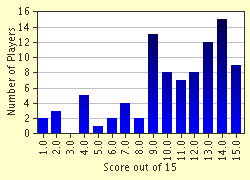Quiz Answer Key and Fun Facts
1. Poirot becomes involved in the case at the behest of Superintendant Spence, who is convinced that James Bentley- the man convicted of the crime- is not guilty. What single characteristic does Spence find lacking in Bentley that is typical of other murderers he has known?
2. Poirot goes to Broadhinney to investigate the murder, and takes lodgings in a guest house run by a young couple- Maureen and Johnnie Summerhayes. The fastidious detective is appalled at the condition of the house and by the chaotic goings on. Which of the following did Poirot NOT have to endure during his stay at the Summerhayes'?
3. Poirot finds that Mrs. McGinty had torn out an article from the Sunday Companion shortly before her murder. The article concerned four "tragic women" who had figured in celebrated murder cases, and asked "Where are these women now?" The four women were Eva Kane, who had been the "other woman" in a famous murder case, Janice Courtland, whose sadistic husband had been killed by her lover, Lily Gamboll, an abandoned adolescent who had killed her aunt in a fit of anger, and Vera Blake, who had been romantically involved with a few unsavory men. The murderer turns out to have been the illegitimate offspring of one of these women; which one?
4. While interviewing Mrs. Sweetiman, the proprietress of the local post office, Poirot discovers that Mrs. McGinty had made a significant purchase on the Monday before she was killed; what did she buy?
5. Which character, apart from Poirot and Spence, is convinced of Bentley's innocence?
6. Poirot is surprised to encounter his friend, mystery author Ariadne Oliver, who is staying at Laburnums with the Upwards. Mrs. Oliver is collaborating with Robin Upward on a stage version of one of her novels and is upset that Robin has completely altered the character of her fictional detective, Sven Hjerson. Which of these is NOT true of Sven Hjerson?
7. By what name does Robin Upward consistently address Mrs. Upward?
8. To his surprise, Poirot discovers a highly unusual object at the Summerhayes' that answers the description of the missing murder weapon. What is it?
9. At a party at Laburnums, a guest says to Robin Upward "I don't like being adopted, do you?" This question indicates (almost imperceptably) that Robin is himself adopted. Who asks this question?
10. Mrs. Upward is found strangled after indicating to Poirot that she has seen one of the photographs before- the photo of Lily Gamboll. She had apparently been taking tea with a guest at the time she was killed; a second teacup stained with lipstick was found across from her in the parlor. In the foyer was the distinct scent of a woman's cologne- specifically one that was frequently used by Eve Carpenter. What did the lipstick and perfume suggest to Poirot?
11. Poirot finds a photograph of Eva Kane in a drawer at the Summerhayes' guest house. On the back, the words "My mother" are written in pencil. The obvious inference would be that the photograph belongs to Mrs. Summerhayes, but Poirot knows this to be false- why?
12. Apart from Deirdre Henderson, one other woman had come to Laburnums on the night of Mrs. Upward's murder and had actually discovered the body before Mrs. Oliver did. Who was the other woman?
13. Halfway through the novel, an attempt is made upon Poirot's life- someone nearly pushes him into the path of an oncoming train. It is discovered that Robin Upward had an airtight alibi for this incident; whom do Poirot and Spence come to believe was the actual culprit?
14. At the end of the novel, Poirot predicts that the newly released James Bentley will begin a romantic relationship with someone, and even plans to assist in encouraging the relationship. Who does Poirot believe will be the "lucky" young lady?
15. To Christie's considerable dismay, a film version of "Mrs. McGinty's Dead" was made in 1964 which replaced Poirot with Miss Marple (portrayed by Margaret Rutherford), and which took numerous other liberties with the story. What was the name of this film?
Source: Author
jouen58
This quiz was reviewed by FunTrivia editor
agony before going online.
Any errors found in FunTrivia content are routinely corrected through our feedback system.

